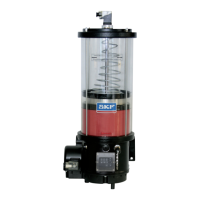Pump units of the KFGC (CAN bus) series for rotary application
24 1-3034-EN
Connections
Power supply
through 7-pin
round plug
CAN bus connection,
plug type DEUTSCH
DT04-3P-L012
Connection for reversing valve/piston detector
(max. 6 connections)
Connectivity
Example of connecting four reversing valves and four piston detectors on devices with the
maximum equipment level (6x M12x1 round plug-in connections) for operating a progressive
feeder system, distributed in four lubrication zones
3V2V1
1
1
1
1
1
1
2
2
2
2
2
2
3
3
3
3
3
3
4
4
4
4
4
4
1
2
3
4
1
2
2
1
2
1
2
1
1
2
3
4
1
2
3
4
1
2
3
4
A B C
1 2
3
4
5 6
7
X1
BN
RD-BK
BU
PK
BK
BK
VT-GN
CAN-BUS
M12x1
1x21M1x21M
M12x1
1x21M1x21M
M12x1
1x21M1x21M
M12x1
F1
S1
M L
31 30
15
CS4 (MC)
V4
SL2
RD
CS1
CS1
CS2
CS2
CS3
CS3
V1 V2 V3
+++++++ + +
–– – – –
CS.. = Piston detector V.. = Reversing valves
Assignment of
round 7-pin plug
Assignment of
round 4-pin plug M12x1
Legend for connection illustration with maximum equipment level
S1 – CS4 Piston detector 1 - 4 V1 – V4 Valves 1 – 4
MC Machine contact SL2 "Fault" indicator light (can alter-
nately be operated in place of
valve 4)
L+ + potential of supply
voltage
F1 Fuse S1 Ignition switch
Assignment of
CAN bus plug
General conditions for electrical connections
The general conditions for electrical connections are identical with those of the KFG and KFGS
series. The data listed below are specific to CAN bus units.
KFGC (CAN bus), general conditions for electrical connections
Switching outputs: Type: Solid-state output, short-circuit-proof and overload-proof
Max. current-carrying - with simultaneous operation of 4 outputs 1.0 A
capacity: - with simultaneous operation of 2 outputs 1.25 A
- with operation of 1 output 1.5 A
Modes of operation: - Single operation
- Parallel connection of multiple outputs while simultaneously increasing
output current
Signal inputs: Type: digital solid-state input, short-circuit-proof
Connectivity: - Switching contact, no detection of wire breakage
- Dual wire sensors (e.g. piston detector), detection of wire breakage

